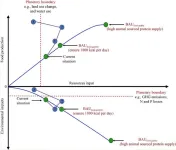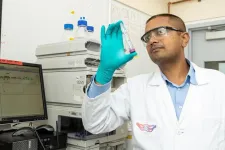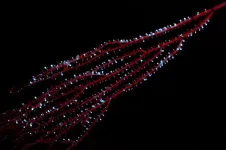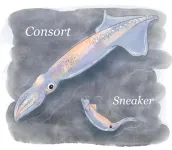(Press-News.org) Traditional non-aqueous lithium-ion batteries have a high energy density, but their safety is compromised due to the flammable organic electrolytes they utilize.
Aqueous batteries use water as the solvent for electrolytes, significantly enhancing the safety of the batteries. However, due to the limited solubility of the electrolyte and low battery voltage, aqueous batteries typically have a lower energy density. This means that the amount of electricity stored per unit volume of aqueous battery is relatively low.
In a new study published in Nature Energy, a research group led by Prof. LI Xianfeng from the Dalian Institute of Chemical Physics (DICP) of the Chinese Academy of Sciences (CAS), in collaboration with Prof. FU Qiang's group also from DICP, developed a multi-electron transfer cathode based on bromine and iodine, realizing a specific capacity of more than 840 Ah/L, and achieving an energy density of up to 1200 Wh/L based on catholyte in full battery testing.
To improve the energy density of aqueous batteries, researchers used a mixed halogen solution of iodide ions (I-) and bromide ions (Br-) as the electrolyte. They developed a multi-electron transfer reaction, transferring I- to iodine element (I2) and then to iodate (IO3-). During the charging process, I- were oxidized to IO3- on the positive side, and the generated H+ were conducted to the negative side in the form of supporting electrolyte. During the discharge process, H+ were conducted from the positive side, and IO3- were reduced to I-.
The developed multi-electron transfer cathode had a specific capacity of 840 Ah/L. Combining the cathode with metallic Cd to form a full battery, researchers achieved an energy density up to 1200 Wh/L based on the developed catholyte.
Besides, researchers confirmed that Br- added to the electrolyte could generate polar iodine bromide (IBr) during the charging process, which facilitated the reaction with H2O to form IO3-. During the discharge, IO3- could oxidize Br- to Br2 and participated in the electrochemical reaction to realize reversible and rapid discharge of IO3-. Therefore, the bromide intermediate formed during the charge and discharge process optimized the reaction process, effectively improving the kinetic and reversibility of the electrochemical reaction.
Prof. FU's group proved the multi-electron transfer process through in-situ optical microscopy, Raman spectroscopy and so on.
"This study provides a new idea for the design of high-energy-density aqueous batteries, and may expand the aqueous batteries application in power batteries field," said Prof. LI.
END
Researchers develop high-energy-density aqueous battery based on halogen multi-electron transfer
2024-04-24
ELSE PRESS RELEASES FROM THIS DATE:
Towards sustainable food systems: global initiatives and innovations
2024-04-24
Contemporary food systems were originally developed to tackle challenges of the mid-20th century, aiming to supply abundant, efficient, non-perishable starchy calories to accommodate the expanding global population. Although substantial progress has been made in global food security over the past several decades, there still exist large populations experiencing hunger worldwide. Currently, global hunger primarily refers to insufficient calorie intake. Hidden hunger is the presence of multiple micronutrient in the absence of an energy-deficit diet. Hidden hunger, particularly the inadequate consumption of high-quality protein, ...
Coral identified as oldest bioluminescent organism, suggesting a new model of ancient ecology
2024-04-24
An international team of researchers, led by Danielle DeLeo from the Smithsonian Institution, has identified eight organisms with previously unknown luminosity. Using genetic findings from these organisms and previous studies, they estimated that coral bioluminescence originated about 540 million years ago in the Cambrian period, making them the earliest bioluminescent organisms. During this period, they shared the oceans with invertebrates with light-sensitive eyes, hinting that interspecies interactions occurred involving light. They published their findings in Proceedings of the Royal Society B.
While shallow-water ...
SRI chosen by DARPA to develop next-generation computational design of metallic parts and intelligent testing of alloys
2024-04-24
SRI announced today that it has been selected by the Defense Advanced Research Projects Agency (DARPA) to deliver advanced technology for its recently launched Multiobjective Engineering and Testing of ALloy Structures (METALS) program.
DARPA METALS aims to break today’s one-material-per-part paradigm, which can lead to vulnerabilities and reduced life when highly engineered components experience austere environments. The goal of the four-year program is to develop technologies that treat material selection – particularly metallic alloys – as a continuous ...
NJIT engineers muffle invading pathogens with a 'molecular mask'
2024-04-24
Vaccines remain the gold standard of protection against dangerous pathogens, but take considerable time and vast resources to develop. Rapidly mutating viruses such as SARS-CoV-2 can blunt their effectiveness and even render them obsolete.
To address these gaps, a multi-university team led by New Jersey Institute of Technology’s Vivek Kumar is developing a hydrogel therapy that acts as a first line of defense against viruses and other biological threats. The peptides that make up this gel prevent viruses ...
Perinatal transmission of HIV can lead to cognitive deficits
2024-04-24
WASHINGTON –Perinatal transmission of HIV to newborns is associated with serious cognitive deficits as children grow older, according to a detailed analysis of 35 studies conducted by Georgetown University Medical Center neuroscientists. The finding helps pinpoint the geographic regions and factors that may be important for brain development outcomes related to perinatal HIV infection: mother-to-child HIV transmission during pregnancy, labor and delivery, or breastfeeding.
The findings appeared in eClinicalMedicine on April 23, 2024.
Mostly because of advances in antiretroviral therapies, AIDS, which is caused by HIV infection, has ...
The consumption of certain food additive emulsifiers could be associated with the risk of developing type 2 diabetes
2024-04-24
In Europe and North America, 30 to 60% of dietary energy intake in adults comes from ultra-processed foods. An increasing number of epidemiological studies suggest a link between higher consumption levels of ultra-processed foods with higher risks of diabetes and other metabolic disorders.
Emulsifiers are among the most commonly used additives. They are often added to processed and packaged foods such as certain industrial cakes, biscuits and desserts, as well as yoghurts, ice creams, chocolate bars, industrial breads, margarines and ready-to-eat or ready-to-heat meals, in order to improve their appearance, taste and texture and lengthen ...
New cancer research made possible as Surrey scientists study lipids cell by cell
2024-04-24
Imagine being able to look inside a single cancer cell and see how it communicates with its neighbours.
Scientists are celebrating a new technique that lets them study the fatty contents of cancer cells, one by one.
A study led by the University of Surrey has sampled single live cancer cells and measured the fatty lipid compounds inside them. Working with partners at GSK and UCL, and developing new equipment with Yokogawa, the team saw how those cells transformed in response to changes in their environment.
Dr ...
Bioluminescence first evolved in animals at least 540 million years ago
2024-04-24
Bioluminescence first evolved in animals at least 540 million years ago in a group of marine invertebrates called octocorals, according to the results of a new study from scientists with the Smithsonian’s National Museum of Natural History.
The results, published today, April 23, in the Proceedings of the Royal Society B, push back the previous record for the luminous trait’s oldest dated emergence in animals by nearly 300 million years, and could one day help scientists decode why the ability to produce light evolved in the first place.
Bioluminescence—the ability of living things to produce light via chemical reactions—has independently ...
Squids’ birthday influences mating
2024-04-24
The day a male spear squid hatches determines which mating tactic he will use throughout his life, according to new research. Spear squid (Heterololigo bleekeri) that hatch earlier in the season become “consorts” which fight for mating opportunities. Those which hatch later become “sneakers,” which use more clandestine mating tactics. Researchers found that the mating tactic determined by the birth date was fixed for the squid’s whole life. Understanding how mating tactics are influenced by birth date, and the environmental conditions at that time, can help researchers consider ...
Star bars show Universe’s early galaxies evolved much faster than previously thought
2024-04-24
Embargoed until 00:01am BST on Wednesday 24 April 2024/19.01pm ET on Tuesday 23 April 2024
-With pictures-
The Universe’s early galaxies were less chaotic and developed much faster than previously thought, according to new research looking back more than ten billion years in time.
An international team of astronomers led by Durham University, UK, used the James Webb Space Telescope (JWST) to find evidence of bar formation when the Universe was only a few billion years old.
Bars are elongated strips of stars found in disc or ...





